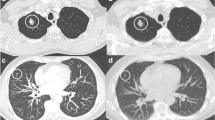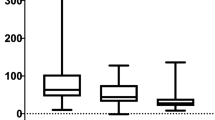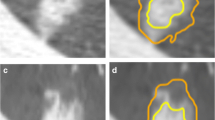Abstract
Objectives
To compare the pulmonary subsolid nodule (SSN) classification agreement and measurement variability between filtered back projection (FBP) and model-based iterative reconstruction (MBIR).
Methods
Low-dose CTs were reconstructed using FBP and MBIR for 47 patients with 47 SSNs. Two readers independently classified SSNs into pure or part-solid ground-glass nodules, and measured the size of the whole nodule and solid portion twice on both reconstruction algorithms. Nodule classification agreement was analyzed using Cohen’s kappa and compared between reconstruction algorithms using McNemar’s test. Measurement variability was investigated using Bland–Altman analysis and compared with the paired t-test.
Results
Cohen’s kappa for inter-reader SSN classification agreement was 0.541–0.662 on FBP and 0.778–0.866 on MBIR. Between the two readers, nodule classification was consistent in 79.8 % (75/94) with FBP and 91.5 % (86/94) with MBIR (p = 0.027). Inter-reader measurement variability range was -5.0–2.1 mm on FBP and -3.3–1.8 mm on MBIR for whole nodule size, and was -6.5–0.9 mm on FBP and -5.5–1.5 mm on MBIR for solid portion size. Inter-reader measurement differences were significantly smaller on MBIR (p = 0.027, whole nodule; p = 0.011, solid portion).
Conclusions
MBIR significantly improved SSN classification agreement and reduced measurement variability of both whole nodules and solid portions between readers.
Key Points
• Low-dose CT using MBIR algorithm improves reproducibility in the classification of SSNs.
• MBIR would enable more confident clinical planning according to the SSN type.
• Reduced measurement variability on MBIR allows earlier detection of potentially malignant nodules.





Similar content being viewed by others
Abbreviations
- SSN:
-
Subsolid nodule
- IR:
-
Iterative reconstruction
- CT:
-
Computed tomography
- MBIR:
-
Model-based iterative reconstruction
- FBP:
-
Filtered back projection
- GGN:
-
Ground-glass nodule
- CTDIvol :
-
Volume CT dose index
- DLP:
-
Dose-length product
- SSDE:
-
Size-specific dose estimate
- ED:
-
Effective dose
- ICRP:
-
International Commission on Radiological Protection
- PACS:
-
Picture archiving and communication system
- HU:
-
Hounsfield unit
- CI:
-
Confidence interval
References
Henschke CI, Yankelevitz DF, Mirtcheva R et al (2002) CT screening for lung cancer: frequency and significance of part-solid and nonsolid nodules. Am J Roentgenol 178:1053–1057
Lee HJ, Lee CH, Jeong YJ et al (2012) IASLC/ATS/ERS International Multidisciplinary Classification of Lung Adenocarcinoma: novel concepts and radiologic implications. J Thorac Imaging 27:340–353
Lee SM, Park CM, Goo JM, Lee HJ, Wi JY, Kang CH (2013) Invasive pulmonary adenocarcinomas versus preinvasive lesions appearing as ground-glass nodules: differentiation by using CT features. Radiology 268:265–273
Kim H, Park CM, Koh JM, Lee SM, Goo JM (2014) Pulmonary subsolid nodules: what radiologists need to know about the imaging features and management strategy. Diagn Interv Radiol 20:47–57
Park CM, Goo JM, Lee HJ, Lee CH, Chun EJ, Im JG (2007) Nodular ground-glass opacity at thin-section CT: histologic correlation and evaluation of change at follow-up. Radiographics 27:391–408
Naidich DP, Bankier AA, MacMahon H et al (2013) Recommendations for the management of subsolid pulmonary nodules detected at CT: a statement from the Fleischner Society. Radiology 266:304–317
Willemink MJ, de Jong PA, Leiner T et al (2013) Iterative reconstruction techniques for computed tomography part 1: technical principles. Eur Radiol 23:1623–1631
Katsura M, Matsuda I, Akahane M et al (2013) Model-based iterative reconstruction technique for ultralow-dose chest CT: comparison of pulmonary nodule detectability with the adaptive statistical iterative reconstruction technique. Investig Radiol 48:206–212
Katsura M, Sato J, Akahane M et al (2013) Comparison of pure and hybrid iterative reconstruction techniques with conventional filtered back projection: image quality assessment in the cervicothoracic region. Eur J Radiol 82:356–360
American Association of Physicists in Medicine (2011) Size-specific dose estimates (SSDE) in pediatric and adult body CT examinations. Task Group 204. American Association of Physicists in Medicine, College Park
Deak PD, Smal Y, Kalender WA (2010) Multisection CT protocols: sex- and age-specific conversion factors used to determine effective dose from dose-length product. Radiology 257:158–166
Svanholm H, Starklint H, Gundersen HJ, Fabricius J, Barlebo H, Olsen S (1989) Reproducibility of histomorphologic diagnoses with special reference to the kappa statistic. APMIS 97:689–698
Bland JM, Altman DG (1999) Measuring agreement in method comparison studies. Stat Methods Med Res 8:135–160
National Lung Screening Trial Research Team, Aberle DR, Adams AM et al (2011) Reduced lung-cancer mortality with low-dose computed tomographic screening. N Engl J Med 365:395–409
Austin JH, Garg K, Aberle D et al (2013) Radiologic implications of the 2011 classification of adenocarcinoma of the lung. Radiology 266:62–71
Chang W, Lee JM, Lee K et al (2013) Assessment of a model-based, iterative reconstruction algorithm (MBIR) regarding image quality and dose reduction in liver computed tomography. Investig Radiol 48:598–606
de Hoop B, Gietema H, van de Vorst S, Murphy K, van Klaveren RJ, Prokop M (2010) Pulmonary ground-glass nodules: increase in mass as an early indicator of growth. Radiology 255:199–206
Kakinuma R, Ashizawa K, Kuriyama K et al (2012) Measurement of focal ground-glass opacity diameters on CT images: interobserver agreement in regard to identifying increases in the size of ground-glass opacities. Acad Radiol 19:389–394
Katsura M, Matsuda I, Akahane M et al (2012) Model-based iterative reconstruction technique for radiation dose reduction in chest CT: comparison with the adaptive statistical iterative reconstruction technique. Eur Radiol 22:1613–1623
Pickhardt PJ, Lubner MG, Kim DH et al (2012) Abdominal CT with model-based iterative reconstruction (MBIR): initial results of a prospective trial comparing ultralow-dose with standard-dose imaging. Am J Roentgenol 199:1266–1274
Volders D, Bols A, Haspeslagh M, Coenegrachts K (2013) Model-based iterative reconstruction and adaptive statistical iterative reconstruction techniques in abdominal CT: comparison of image quality in the detection of colorectal liver metastases. Radiology 269:469–474
Vardhanabhuti V, Loader RJ, Mitchell GR, Riordan RD, Roobottom CA (2013) Image quality assessment of standard- and low-dose chest CT using filtered back projection, adaptive statistical iterative reconstruction, and novel model-based iterative reconstruction algorithms. Am J Roentgenol 200:545–552
Yamada Y, Jinzaki M, Tanami Y et al (2012) Model-based iterative reconstruction technique for ultralow-dose computed tomography of the lung: a pilot study. Investig Radiol 47:482–489
Yasaka K, Katsura M, Akahane M, Sato J, Matsuda I, Ohtomo K (2013) Model-based iterative reconstruction for reduction of radiation dose in abdominopelvic CT: comparison to adaptive statistical iterative reconstruction. SpringerPlus 2:209
Chang B, Hwang JH, Choi YH et al (2013) Natural history of pure ground-glass opacity lung nodules detected by low-dose CT scan. Chest 143:172–178
Lim HJ, Ahn S, Lee KS et al (2013) Persistent pure ground-glass opacity lung nodules ≥ 10 mm in diameter at CT scan: histopathologic comparisons and prognostic implications. Chest 144:1291–1299
Arenas-Jimenez J (2013) Measurement of solid component in part-solid lesions with a mediastinal window setting? Radiology 268:305–306
Acknowledgements
The scientific guarantor of this publication is Chang Min Park, MD, PhD. The authors of this manuscript declare no relationship with any companies whose products or services may be related to the subject matter of the article. No complex statistical methods were necessary for this paper. Institutional Review Board approval was obtained. Written informed consent was waived by the Institutional Review Board. Study subjects have not been previously reported in other journals. Methodology: retrospective diagnostic study, performed at one institution.
This study was supported by a research grant from the Korean Foundation for Cancer Research (grant number: CB-2011-02-01).
Author information
Authors and Affiliations
Corresponding author
Rights and permissions
About this article
Cite this article
Kim, H., Park, C.M., Kim, S.H. et al. Persistent pulmonary subsolid nodules: model-based iterative reconstruction for nodule classification and measurement variability on low-dose CT. Eur Radiol 24, 2700–2708 (2014). https://doi.org/10.1007/s00330-014-3306-7
Received:
Revised:
Accepted:
Published:
Issue Date:
DOI: https://doi.org/10.1007/s00330-014-3306-7




